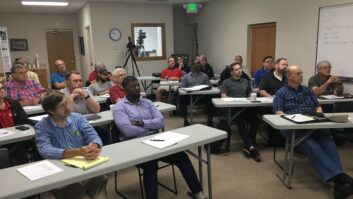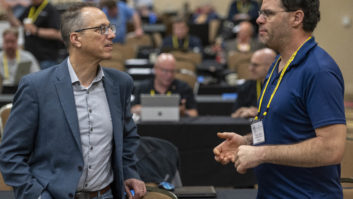For many years to come, people throughout the U.S., the South in particular, will remember the last week of April 2011.
It is seared into their memories as the time when an unprecedented tornado outbreak ravaged Dixie from Mississippi to Georgia.

Our chief engineer’s house sustained only minor damage, but this neighbor was not so fortunate.
I will be one of those who long remember the last Wednesday in April. It started with an early-morning text message from Stephen Poole, our Birmingham market chief engineer. He briefly told me that a tornado had gone through his neighborhood north of Birmingham before 6 a.m. It tore a few shingles from his roof but destroyed the homes of some of his neighbors. Stephen and his wife Sandy were shaken but okay, and they were of course thankful that they and their home had escaped unharmed.
Later in the day, I got another text from Stephen telling me that the skies were starting to get ugly again and that they were hunkering down for another round of severe storms. That was the line of storms that produced the big tornado outbreak, including the mile-wide monster that stayed on the ground for 200 miles, destroying Tuscaloosa and the north part of Birmingham.
I watched the Weather Channel in awe as its cameras followed that huge, black wedge. The primary camera was on top of Red Mountain, just a mile or so northeast of our studio site, looking north. I prayed as I watched the wedge slowly creep from left to right on the screen, noting visible landmarks and thinking about what was in the path … our 850 site with its five towers at Tarrant, our 1260 site northeast of downtown …
Another tornado was moving from west to east about 60 miles north, cutting a path through Cullman and destroying the town. We have a 1,380-foot tower just a couple of miles south of Cullman.
As the storms moved off to the east, I started trying to get in touch with Stephen to no avail. I did get in touch with Todd Dixon, one of our other engineers, and he told me that all the signals were on the air. That was a huge relief! At least I knew that we hadn’t sustained a direct hit on any of the sites.

End of the line. Our engineers could drive no farther up the road to the Ishkooda site.
I did finally get in touch with Stephen that evening. The tornado that had plowed through his neighborhood earlier in the day had evidently taken out power to the Verizon site in that area, leaving him with very spotty service. Landlines and power were all down in his neighborhood.
Aftermath
As the sun rose the following day, we started getting a look at the damage the storm had left. Amazingly, the three of our sites without emergency generators were up and operating on commercial power. The two 100 kW FMs that had generators were operating on generator power with the commercial mains out. We were okay for the moment, but we realized that the clock was definitely ticking on both the fuel and the longevity of those engines running continuously.
Alabama Power was telling us that it would take days to get the power back on at the Ishkooda mountaintop site, and there was no estimate on restoration at the Cullman site, where the electrical generating plant reportedly had been heavily damaged. We knew we were going to be on our own for quite awhile.
Our people quickly found that with all the tornado damage in the area, fuel delivery was not going to happen anytime soon. Fuel jobbers were being tasked with priority and public service applications. Radio stations were a long way down the list.
In the case of the Ishkooda site, it was a moot point anyway — the road up to the site was completely blocked by fallen trees: big ones, many of which were also tangled in overhead power distribution wires.
I asked Stephen about taking a chain saw and cutting some of those trees. He understandably was hesitant. The overhead power lines evidently were dead but they could come to life at any moment. So he had to haul fuel in five-gallon cans about two-tenths of a mile up that steep road, stepping over and around the tangle of fallen trees, to keep the generator fueled.
The road was relatively clear up at the Cullman site. Once the authorities opened the interstate up that way, our engineers were able to borrow a farm truck, drive it some distance south of Birmingham, fill its 100-gallon tank with diesel and drive it up to the Cullman site to fuel the generator. Those 100 gallons would hold us for less than 24 hours.

Refueling the generator at the Cullman site from a 55-gallon drum was part of the daily grind until the power came back on.
The decision was quickly made to shut the Cullman station down between 10 p.m. and 6 a.m. to save on fuel and wear and tear on the generator. The FAA was notified that the tower lights would be out for a few days. Every evening at 10, one of our engineers would drive the 60 miles to the Cullman site to shut down the transmitter and generator. Every morning at 6, someone else would make the drive, fire up the generator and turn on the transmitter. And so began the long grind.
Stephen found a fuel jobber that would sell us diesel in 55-gallon drums, and they would sell us a hand pump and hose. Three different times, Stephen drove his pickup to the oil terminal and had them load two drums of fuel. He would then make the long drive, pump the fuel into the generator tank and make the drive back with the empties.
Essential maintenance
At one point during the week following the tornados, we made the decision to shut the generator down during daylight hours and change the oil. Not surprisingly, it was black and gritty. The typical standby generator at a radio transmitter site is not meant to run continuously for days on end, and the manufacturers have told us that should they be pressed into that kind of service, special attention must be paid to the oil and coolant.
Our friends at Clear Channel share the access road up to the Ishkooda site with us, and their generator ran completely out of fuel on the Saturday after the tornados. Bob Newberry, no doubt exhausted after several days of dealing with storm damage in both Tuscaloosa and Birmingham, decided that if he didn’t clear a path through the fallen trees, it wasn’t going to happen. He wore out two chain saws making a hole wide enough to drive a pickup through. Bob got his generator fueled, primed and running again, and we got some fuel into ours as well (we were down to just a few gallons in the tank but had not yet run out).

Clear Channel’s WTXT in Tuscaloosa lost its tower in the storm. Photo courtesy of Bob Newberry
Stephen’s neighbor is a Birmingham city police officer. Talking to him one day in the aftermath of the storms, Stephen told him that the city’s trunking system is located on our Ishkooda tower and that if the generator runs out of fuel, the city and county will have no radio communications for its police, fire, sheriff, EMS, meter maids and dog catcher.
The neighbor called his boss, who in turn called someone else. That evidently got power restoration at the Ishkooda site moved up the priority list. By Sunday afternoon, four days after the outbreak, the trees were cleared and power was restored.
Even though we had been told it might be more than a week more before power would be restored at the Cullman site, the juice came back on the following Tuesday. Six days after the worst tornado outbreak on record, all sites were up and running on commercial power.
We had one additional casualty to deal with. The plate contactor in the BE FM-30T main transmitter at the Ishkooda site was damaged and closing only two phases. This probably occurred when the power first went down and phase wires got crossed as trees fell across them. That contactor was replaced after the power was back up at all the sites, returning that station to full-power operation and marking the return of our market operations to “normal.”
What we learned
So what did we learn from this experience?
(click thumbnail)
This satellite view from the National Weather Service shows the track of a major tornado that passed through the Birmingham area. The gray area in the center at the bottom of the image is Crawford Broadcasting’s five-tower directional array on 850 kHz.

First, our disaster plans had always assumed that only one of the sites would be impacted. Tornados tend to be localized; it’s very unusual — almost unprecedented — for a tornado to stay on the ground for 200+ miles and be more than a mile wide. It’s also very unusual to have such a huge outbreak of tornados over such a large area.
But the bottom line is that we had two sites seriously affected, and we could have had more. Our contingency plans must, from here on, provide for multiple site involvement.
Another lesson is to keep the generator tanks full during storm season.
From normal exercising and periodic power-out operation, we were probably down to half a tank at the Cullman site when the storm hit. That had us playing catch-up from the first pitch.
We also learned that we need to keep oil, filters and coolant on hand at the sites. Changing the oil during prolonged operation is a must, and normal supply lines may be severed (as they were in this instance).
Finally, I relearned what I already knew: Our engineers are rock stars, the heroes of the story in the aftermath of any disaster.
Stephen and his crew set aside their personal lives for a week and focused all their energies on keeping the stations on the air. Without them and their superhuman efforts, two of our five stations would have been dead in the water for days.
Hopefully, we will never again face such wide destruction, but forewarned is forearmed. We’ll be better prepared next time.
W.C. “Cris” Alexander is director of engineering at Crawford Broadcasting Company and a past recipient of the SBE’s Broadcast Engineer of the Year Award.












